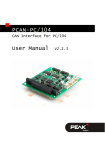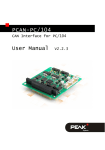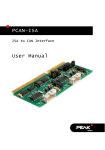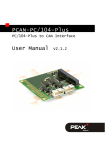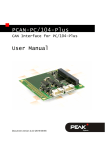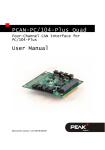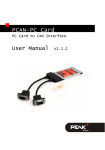Download PCAN-PC/104 - User Manual - PEAK
Transcript
PCAN-PC/104 CAN Interface for PC/104 User Manual Document version 2.3.1 (2014-03-27) PCAN-PC/104 – User Manual Products taken into account Product Name Model Part number PCAN-PC/104 Single Channel One CAN channel IPEH-002054 PCAN-PC/104 Dual Channel Two CAN channels IPEH-002055 PCAN-PC/104 Single Channel opto-decoupled One CAN channel, galvanic isolation for CAN connection IPEH-002056 PCAN-PC/104 Dual Channel opto-decoupled Two CAN channels, galvanic isolation for CAN connections IPEH-002057 The cover picture shows the product PCAN-PC/104 Dual Channel opto-decoupled. Other product models have an identical form factor but vary in equipment. CANopen® and CiA® are registered community trade marks of CAN in Automation e.V. All other product names mentioned in this document may be the trademarks or registered trademarks of their respective companies. They are not explicitly marked by “™” and “®”. © 2014 PEAK-System Technik GmbH PEAK-System Technik GmbH Otto-Roehm-Strasse 69 64293 Darmstadt Germany Phone: +49 (0)6151 8173-20 Fax: +49 (0)6151 8173-29 www.peak-system.com [email protected] Document version 2.3.1 (2014-03-27) 2 PCAN-PC/104 – User Manual Contents 1 1.1 1.2 1.3 2 Introduction 5 Properties at a Glance System Requirements Scope of Supply Installing and Configuring the Software and the Card 5 6 7 8 2.1 Configuring the Card 2.1.1 Interrupt 2.1.2 I/O Address Range 2.2 Installing the Software and the Card 2.3 Modifying the Computer's BIOS Settings 2.3.1 Indicating Used Interrupts 2.3.2 Deactivating the APIC Mode 8 9 10 12 13 14 14 3 16 Connecting the CAN Bus 3.1 D-Sub Connector 3.1.1 Slot Bracket with D-Sub Connectors 3.2 Supplying External Devices via the CAN Connector 3.3 Cabling 3.3.1 Termination 3.3.2 Example of a Connection 3.3.3 Maximum Bus Length 16 18 4 23 Using the Software 4.1 PCAN-View for Windows 4.1.1 Receive/Transmit Tab 4.1.2 Trace Tab 4.1.3 Status Bar 4.2 Linking Own Programs with PCAN-Basic 3 19 21 21 21 22 23 26 28 29 30 PCAN-PC/104 – User Manual 4.2.1 4.2.2 4.2.3 5 Features of PCAN-Basic Principle Description of the API Notes about the License Technical Specifications 31 32 33 34 Appendix A CE Certificate 36 Appendix B Dimension Drawing 37 Appendix C Quick Reference 38 4 PCAN-PC/104 – User Manual 1 Introduction The PCAN-PC/104 card enables the connection of one or two CAN networks to a PC/104 system. Multiple PCAN-PC/104 cards can easily be operated using interrupt sharing. The opto-decoupled versions also guarantee galvanic isolation of up to 500 Volts between the PC and the CAN sides. Device drivers and programming interfaces exist for different operating systems, so programs can easily access a connected CAN bus. Tip: At the end of this manual (Appendix C) you can find a Quick Reference with brief information about the installation and operation of the PCAN-PC/104 card. 1.1 Properties at a Glance Form factor PC/104 Multiple PC/104 cards can be operated in parallel (interrupt sharing) 14 port and 8 interrupt addresses are available for configuration using jumpers 1 or 2 High-speed CAN channels (ISO 11898-2) Compliant with CAN specifications 2.0A (11-bit ID) and 2.0B (29-bit ID) NXP CAN controller SJA1000, 16 MHz clock frequency NXP CAN transceiver PCA82C251 Connection to CAN bus through D-Sub slot bracket, 9-pin (in accordance with CiA® 102) Bit rates from 5 kbit/s up to 1 Mbit/s 5 PCAN-PC/104 – User Manual Galvanic isolation on the CAN connection up to 500 V (only opto-decoupled models), separate for each CAN channel 5-Volts supply to the CAN connection can be connected through a solder jumper, e.g. for external bus converter Extended operating temperature range of -40 to +85 °C (-40 to +185 °F) Note: This manual describes the use of the PCAN-PC/104 card with Windows. You can find device drivers for Linux and the corresponding application information on the provided DVD in the directory branch Develop and on our website under www.peak-system.com/linux. 1.2 System Requirements PC/104 stack with ISA bus (according to the PC/104 specification) Operating system Windows 8, 7, Vista (32/64-bit), or Windows CE 6.x (x86 and ARMv4 processor support), or Linux (32/64-bit) 6 PCAN-PC/104 – User Manual 1.3 Scope of Supply PCAN-PC/104 card Slot bracket with D-Sub connectors for the CAN bus Device drivers for Windows 8, 7, Vista and Linux (32/64-bit) Device driver for Windows CE 6.x (x86 and ARMv4 processor support) PCAN-View CAN monitor for Windows 8, 7, Vista (32/64-bit) PCAN-View CAN monitor for DOS PCAN-Basic programming interface consisting of an interface DLL, examples, and header files for all common programming languages Manual in PDF format 7 PCAN-PC/104 – User Manual 2 Installing and Configuring the Software and the Card This chapter covers the configuration, the software setup for the PCAN-PC/104 card under Windows, and the card installation in the computer. 2.1 Configuring the Card Before installing the PCAN-PC/104 card into the computer you may need to configure it. For each CAN channel an interrupt (IRQ) and an I/O address range is set for operation in the computer. At delivery the PCAN-PC/104 card has the following default settings: CAN Channel IRQ I/O Address Range 1 10 300h – 31Fh 2 5 320h – 33Fh Comment Dual Channel model only Tip: If the given resources are not permanently allocated by other devices, you can skip the configuration and directly continue with the following manual section 2.2 on page 12. For a configuration differing from the default settings you need to set jumpers on the PCAN-PC/104 PCB according to the following explanations. Attention! Electrostatic discharge (ESD) can damage or destroy components on the PCAN-PC/104 card. Take precautions to avoid ESD when handling the card. 8 PCAN-PC/104 – User Manual 2.1.1 Interrupt An interrupt (IRQ) must be assigned to each CAN channel. This is done with a single jumper on jumper field JP1 for CAN channel 1 and jumper field JP2 for CAN channel 2 (latter refers only to the Dual Channel model). The PCAN-PC/104 card supports the interrupts 3, 4, 5, 7, 10, 11, 12, and 15. The default setting at delivery for CAN channel 1 is interrupt 10, for CAN channel 2 interrupt 5. Figure 1: Position of the jumper fields for setting the interrupts, JP1 for CAN channel 1 (lower jumper field), JP2 for CAN channel 2 (upper jumper field, Dual Channel model only) It is possible to share the same interrupt between two existing CAN channels. Therefore you can configure the same interrupt when using two PCAN-PC/104 cards in the same computer. Tip: We suggest to configure different interrupts as long as resources allow it and use interrupt sharing only if this is not the case. 9 PCAN-PC/104 – User Manual 2.1.2 I/O Address Range Each CAN channel must be assigned to an unique I/O address range in the computer. An address space from 200h up to 39Fh and 3E0h to 3FFh (h = hexadecimal) is available. PCAN-PC/104 uses 32 addresses beginning from the configured base address. The configuration is done on jumper field JP3 for CAN channel 1 and jumper field JP4 for CAN channel 2 (latter refers only to the Dual Channel model). One or several jumpers are needed for each jumper field. Figure 2: Position of the jumper fields for setting the I/O base addresses, JP3 for CAN channel 1 (left jumper field), JP4 for CAN channel 2 (right jumper field, Dual Channel model only) The following table shows the possible settings. The X stands for a set jumper. The default settings at delivery for CAN channels 1 and 2 are highlighted. Continued on the next page 10 PCAN-PC/104 – User Manual Jumper field JP3/JP4 A B C D E X 200h – 21Fh X X X X X X X X X X 220h – 23Fh 240h – 25Fh X 260h – 27Fh 280h – 29Fh X X X X X X X I/O address range X 2A0h – 2BFh X 2E0h – 2FFh 2C0h – 2DFh X 300h – 31Fh X X X X X X X X X X X X X X X 320h – 33Fh 340h – 35Fh X 360h – 37Fh 380h – 39Fh X X 3E0h – 3FFh 11 PCAN-PC/104 – User Manual 2.2 Installing the Software and the Card Setup the driver before inserting the card. Do the following to install the driver: 1. Make sure that you are logged in as user with administrator privileges (not needed for normal use of the card later on). 2. Insert the supplied DVD into the appropriate drive of the computer. Usually a navigation program appears a few moments later. If not, start the file Intro.exe from the root directory of the DVD. 3. On the page English > Drivers activate the entry PCAN-ISA. 4. Click on Install now. The setup program for the driver is executed. 5. Follow the instructions of the program. Tip: If you do not want to install the CAN monitor PCAN-View for Windows onto the hard disk together with the driver, you have the option to start the program later directly from DVD without prior installation. Do the following to install the PCAN-PC/104 card in the computer: Attention! Electrostatic discharge (ESD) can damage or destroy components on the PCAN-PC/104 card. Take precautions to avoid ESD when handling the card. Shut down the computer. 6. Disconnect the computer from the power supply. 7. Plug the PCAN-PC/104 card onto a PC/104 connector. For details refer to the documentation of the computer. 12 PCAN-PC/104 – User Manual 8. Interconnect the connector for each CAN channel on the PCAN-PC/104 card (see Figure 3) with the CAN connector of the slot bracket using the attached flat cable. Figure 3: Connectors for the flat cables to the CAN connectors, J3 for CAN channel one (lower position), J4 for CAN channel 2 (upper position, Dual Channel model only) 9. Reconnect the power supply of the computer. Note: Before switching on the computer, please follow the procedure for modifying the computer's BIOS settings described in the following section. 2.3 Modifying the Computer's BIOS Settings To ensure a flawless operation of the PCAN-PC/104 card it is necessary that you adjust settings in the BIOS setup of the computer: Indicate used interrupts Deactivate the APIC mode 13 PCAN-PC/104 – User Manual Note: Due to a diversity of existing BIOS setup versions for computers we cannot give detailed instructions here. Instead we indicate common setting names. In order to know how to start the computer's BIOS setup please consult the corresponding documentation. Usually you can enter the BIOS setup by pressing the Del or F2 key shortly after switching on the computer. 2.3.1 Indicating Used Interrupts By indicating the interrupts that are set on the PCAN-PC/104 card, you avoid that the corresponding resources are automatically assigned to other devices and that this results in conflicts. In the BIOS setup itself you can often find the settings for the interrupts under a menu item containing the text “PnP”. For the interrupt(s) used by PCAN-PC/104 change the setting to “Reserved” or “Legacy ISA”. 2.3.2 Deactivating the APIC Mode Note: Do not mix up APIC with ACPI. The APIC mode is a certain type of interrupt management in a computer. If the APIC mode is active in your computer, you must deactivate it so that the PCAN-PC/104 card can work properly with interrupts. Do the following to determine in Windows if the APIC mode is active: Open the Windows Device Manager. 10. Select the menu entry View > Resources by type. 14 PCAN-PC/104 – User Manual 11. Open the branch of Interrupt request (IRQ). If entries with interrupt numbers greater than 15 are listed, the APIC mode is active and you must deactivate it. Do the following to deactivate the APIC mode: Important note: When you deactivate the APIC mode in the BIOS setup, it may happen that you must reinstall Windows afterwards, because it cannot start anymore due to the lowlevel setting. Restart the computer and switch to the BIOS setup. 12. Search for the APIC setting and deactivate it. 13. Save the changes in the BIOS and quit the BIOS setup. 14. If Windows doesn't start properly, reinstall it or perform a repair installation. 15 PCAN-PC/104 – User Manual 3 3.1 Connecting the CAN Bus D-Sub Connector A High-speed CAN bus (ISO 11898-2) is connected to the 9-pin D-Sub connector. The pin assignment corresponds to the specification CiA® 102. Figure 4: Pin assignment High-speed CAN (view onto connector of the slot bracket) With the pins 1 and 9 devices with low power consumption (e.g. an external bus converter) can be directly supplied via the CAN connector. At delivery these pins are not assigned. You can find a detailed description about the activation in the following section 3.2. 16 PCAN-PC/104 – User Manual The pin assignment between the D-Sub port and the 10-pin connector on the PCAN-PC/104 card is as follows: Figure 5: Numbering at the 10-pin connector Pin Assignment Assignment D-Sub 1 +5 V (optional) 1 2 GND 6 3 CAN_L 2 4 CAN_H 7 5 GND 3 6 not connected 8 7 not connected 4 8 +5 V (optional) 9 9 not connected 5 10 not connected Tip: You can connect a CAN bus with a different transmission standard via a bus converter. PEAK-System offers different bus converter modules (e.g. PCAN-TJA1054 for a Low-speed CAN bus according to ISO 11898-3). 17 PCAN-PC/104 – User Manual 3.1.1 Slot Bracket with D-Sub Connectors Figure 7: Dual channel slot bracket Figure 6: Single channel slot bracket To connect a CAN bus to the PCAN-PC/104 card, use the supplied slot brackets. After you have connected the cables from the slot bracket with the 10-pin sockets, you can connect the CAN busses with the D-Sub sockets. 18 PCAN-PC/104 – User Manual 3.2 Supplying External Devices via the CAN Connector You can route a 5-Volt supply to pin 1 and/or pin 9 of the CAN connector (independently for each CAN connector on the Dual Channel model) by setting solder jumpers on the PCAN-PC/104 card. Thus devices with low power consumption (e.g. a bus converter) can be directly supplied via the CAN connector. When using this option the 5-Volt supply is connected to the power supply of the computer and is not fused separately. The optodecoupled models of the card contain an interconnected DC/DC converter. Therefore the current output is limited to about 50 mA. Proceed as follows to activate the 5-Volt supply: Attention! Electrostatic discharge (ESD) can damage or destroy components on the PCAN-PC/104 card. Take precautions to avoid ESD when handling the card. Set the solder jumpers on the PCAN-PC/104 card according to the desired settings. During this procedure take especially care not to produce unwanted short circuits on the card. Figure 8 shows the positions of the solder fields on the PCANPC/104 card. The table below contains the possible settings. 19 PCAN-PC/104 – User Manual Figure 8: Position of the solder jumper fields for the 5-Volt supply (JP5 lower position, JP6 upper position) 5-Volt supply → None Pin 1 Pin 9 Pin 1 + Pin 9 JP5 (CAN channel 1) / JP6 (CAN channel 2) Attention! Risk of short circuit! If the option described in this section is activated, you may only connect or disconnect CAN cables or peripheral systems (e.g. an external bus converter) to or from the PCAN-PC/104 card while the computer is deenergized. 20 PCAN-PC/104 – User Manual 3.3 3.3.1 Cabling Termination A High-speed CAN bus (ISO 11898-2) must be terminated on both ends with 120 Ohms. Otherwise, there are interfering signal reflections and the transceivers of the connected CAN nodes (CAN interface, control unit) will not work. The PCAN-PC/104 card does not have an internal termination. Use the adapter on a terminated CAN bus. 3.3.2 Example of a Connection Figure 9: Simple CAN connection In this example, the PCAN-PC/104 card is connected with a control unit by a cable that is terminated at both ends. 21 PCAN-PC/104 – User Manual 3.3.3 Maximum Bus Length High-Speed-CAN networks may have bit rates of up to 1 Mbit/s. The maximum bus length is primarily depending on the bit rate. The following table shows the maximum CAN bus length at different bit rates: Bit rate Bus length 1 Mbit/s 40 m 500 kbit/s 110 m 250 kbit/s 240 m 125 kbit/s 500 m 50 kbit/s 1.3 km 20 kbit/s 3.3 km 10 kbit/s 6.6 km 5 kbit/s 13.0 km The listed values have been calculated on the basis of an idealized system and can differ from reality. 22 PCAN-PC/104 – User Manual 4 Using the Software This chapter covers the provided software PCAN-View and the programming interface PCAN-Basic. 4.1 PCAN-View for Windows PCAN-View for Windows is a simple CAN monitor for viewing, transmitting, and logging CAN messages. Figure 10: PCAN-View for Windows Do the following to start and initialize PCAN-View: 1. If PCAN-View is already installed on the hard disk, open the Windows Start menu, go to Programs > PCAN-Hardware, and select the entry PCAN-View. 23 PCAN-PC/104 – User Manual If you haven't installed PCAN-View together with the device driver, you can start the program directly from the supplied DVD. In the navigation program (Intro.exe) go to English > Tools, and under PCAN-View for Windows select the link Start. The dialog box for selecting the CAN hardware and for setting the CAN parameters appears. Figure 11: Selection of the CAN specific hardware and parameters If there is no entry in the list Available CAN hardware (for example at the first program start), you need to add one: Run PCAN-View with administrator privileges (Windows XP: user login with corresponding privileges, Windows Vista, 7 and 8: via the context menu of PCAN-View's Start menu entry). 2. Click on the Add button. The dialog box Add CAN hardware appears. 24 PCAN-PC/104 – User Manual Figure 12: Selection of the hardware 3. Select the connected hardware and the operating mode from the list Type of CAN hardware, in this case PEAK ISACAN SJA. 4. Enter the I/O Address and the Interrupt, as they are set on the PCAN-PC/104 card (see section 2.1 Configuring the Card on page 8). Default setting on the card at delivery: CAN Channel IRQ I/O Address Range 1 10 300h – 31Fh 2 5 320h – 33Fh Comment Dual Channel model only 5. Confirm your input with OK. 6. From the list Available CAN hardware select the CAN channel to be used. 7. Select the Bit rate that is used by all nodes on the CAN bus. 8. Under Filter settings you can limit the range of CAN IDs to be received, either for standard frames (11-bit IDs) or for extended frames (29-bit IDs). 9. Finally confirm the settings in the dialog box with OK. The main window of PCAN-View appears (see Figure 13). 25 PCAN-PC/104 – User Manual 4.1.1 Receive/Transmit Tab Figure 13: Receive/Transmit tab The Receive/Transmit tab is the main element of PCAN-View. It contains two lists, one for received messages and one for the transmit messages. Representation of CAN data is in hexadecimal format. Do the following to transmit a CAN message with PCAN-View: Select the menu command Transmit > New Message (alternatively or Ins). The dialog box New Transmit Message is shown. 26 PCAN-PC/104 – User Manual Figure 14: Dialog box New transmit message 10. Enter the ID and the data for the new CAN message. 11. The field Cycle Time indicates if the message shall be transmitted manually or periodically. If you want to transmit the message periodically, you must enter a value greater than 0. For a manual-only transmission enter 0. 12. Confirm the entries with OK. The created transmit message appears on the Receive/Transmit tab. 13. You trigger selected transmit messages manually with the menu command Transmit > Send (alternatively Space bar). The manual transmission for CAN messages being transmitted periodically is carried out additionally. Tip: Using the menu command File > Save the current transmit messages can be saved to a list and loaded for reuse later on. 27 PCAN-PC/104 – User Manual 4.1.2 Trace Tab Figure 15: Trace tab On the Trace tab the data tracer of PCAN-View is used for logging the communication on a CAN bus. During this process the CAN messages are cached in the working memory of the PC. Afterwards they can be saved to a file. The tracer can be configured to run in linear or in ring buffer mode. In linear buffer mode the logging is stopped as soon as the buffer is filled completely. In ring buffer mode the oldest messages are overwritten by incoming ones. 28 PCAN-PC/104 – User Manual 4.1.3 Status Bar Figure 16: Display of the status bar The status bar shows information about the current CAN connection, about error counters (Overruns, QXmtFull), and shows error messages. You can find further information about the use of PCAN-View in the help which you can invoke in the program via the Help menu or with the F1 key. 29 PCAN-PC/104 – User Manual 4.2 Linking Own Programs with PCAN-Basic Figure 17: PCAN-Basic On the provided DVD you can find files of the programming interface PCAN-Basic in the directory branch Develop. This API provides basic functions for linking own programs to CAN interfaces by PEAK-System and can be used for the following operating systems: Windows 8, 7, Vista (32/64-bit) Windows CE 6.x (x86/ARMv4) Linux (32/64-bit) The API is designed for cross-platform use. Therefore software projects can easily ported between platforms with low efforts. PEAKSystem has created examples for the following programming languages: C++, C#, C++/CLR, Visual Basic, Delphi, Python, and Java. 30 PCAN-PC/104 – User Manual 4.2.1 Features of PCAN-Basic Supports Windows 8, 7, Vista (32/64-bit), Windows CE 6.x and Linux (32/64-bit) operating system Multiple PEAK-System applications and your own can be operated on a physical CAN channel at the same time Use of a single DLL for all supported hardware types Use of up to 8 channels for each hardware unit (depending on the PEAK CAN interface used) Simple switching between channels of a PEAK CAN interface Driver-internal buffering of 32,768 messages per CAN channel Precision of time stamps on received messages up to 1 μs (depending on the PEAK CAN interface used) Access to specific hardware parameters, such as listen-only mode Notification of the application through Windows events when a message is received Extended system for debugging operations Multilingual debugging output Output language depends on operating system Debugging information can be defined individually An overview of the API functions is located in the header files. You can find detailed information about the PCAN-Basic API on the provided DVD in the text and help files (file name extensions .txt and .chm). 31 PCAN-PC/104 – User Manual 4.2.2 Principle Description of the API The PCAN-Basic API is the interface between the user application and device driver. In Windows operating systems this is a DLL (Dynamic Link Library). The sequence of accessing the CAN interface is divided into three phases: 1. Initialization 2. Interaction 3. Completion Initialization A CAN channel must be initialized before using it. This is done by the simple call of the function CAN_Initialize. Depending on the type of the CAN hardware, up to eight CAN channels can be opened at the same time. After a successful initialization the CAN channel is ready for communication with the CAN hardware and the CAN bus. No further configuration steps are required. Interaction For receiving and transmitting CAN messages the functions CAN_Read and CAN_Write are available. Additional settings can be made, e.g. setting up message filters to confine to specific CAN IDs or setting the CAN controller to listen-only mode. When receiving CAN messages, events are used for an automatic notification of an application (client). This offers the following advantages: The application no longer needs to check for received messages periodically (no polling). The response time at reception is reduced. 32 PCAN-PC/104 – User Manual Completion To end the communication the function CAN_Uninitialize is called in order to release the reserved resources for the CAN channel, among others. In addition the CAN channel is marked as "Free" and is available to other applications. 4.2.3 Notes about the License Device drivers, the interface DLL, and further files needed for linking are property of the PEAK-System Technik GmbH and may be used only in connection with a hardware component purchased from PEAK-System or one of its partners. If a CAN hardware component of third-party suppliers should be compatible to one of PEAKSystem, then you are not allowed to use or to pass on the driver software of PEAK-System. If a third-party supplier develops software based on the PCAN-Basic and problems occur during the use of this software, consult the software provider. 33 PCAN-PC/104 – User Manual 5 Technical Specifications Connectors PC/104 ISA bus with 8 MHz clock rate, 16 bit bus width CAN D-Sub (m), 9 pins Pin assignment according to specification CiA® 102 CAN Specification ISO 11898-2, High-speed CAN 2.0A (standard format) and 2.0B (extended format) Bit rates 5 kbit/s - 1 Mbit/s Controller NXP SJA1000 Transceiver NXP PCA82C251 Galvanic isolation PCAN-PC/104: none PCAN-PC/104 opto: up to 500 V, separate for each CAN channel Supplying external devices PCAN-PC/104: D-Sub pin 1/9; 5 V, max. 100 mA PCAN-PC/104 opto: D-Sub pin 1/9; 5 V, max. 50 mA Not assigned at delivery Termination none Power supply Supply voltage 5V Current consumption PCAN-PC/104 Single Channel: PCAN-PC/104 Dual Channel: PCAN-PC/104 Single Channel opto: PCAN-PC/104 Dual Channel opto: Continued on the next page 34 max. 150 mA max. 170 mA max. 210 mA max. 270 mA PCAN-PC/104 – User Manual Environment Operating temperature -40 - +85 °C (-40 - +185 °F) Temperature for storage and transport -40 - +125 °C (-40 - +257 °F) Relative humidity 15 - 90 %, not condensing EMC EN 55024:2011-09 EN 55022:2011-12 EC directive 2004/108/EG Measures Size 96 x 91 x 24 mm (see also dimension drawing Appendix B on page 37) Weight PCAN-PC/104 Single Channel: PCAN-PC/104 Dual Channel: PCAN-PC/104 Single Channel opto: PCAN-PC/104 Dual Channel opto: 35 57 g 63 g 59 g 65 g PCAN-PC/104 – User Manual Appendix A CE Certificate 36 PCAN-PC/104 – User Manual Appendix B Dimension Drawing Figure 18: View PCAN-PC/104 The figure does not show the actual size of the product. 37 PCAN-PC/104 – User Manual Appendix C Quick Reference Default setting at delivery CAN Channel IRQ I/O Address Range 1 10 300h – 31Fh 2 5 320h – 33Fh Comment Dual Channel model only Software/Hardware Installation under Windows Before installing the PCAN-PC/104 card in the PC/104 stack, please setup the corresponding software package from the supplied DVD (with administrator privileges). After switching on the computer enter the BIOS setup. In the PnP table mark the interrupts used by the PCAN-PC/104 card as reserved. Getting Started under Windows Run the CAN monitor PCAN-View from the Windows Start menu as a sample application for accessing the PCAN-PC/104 card. For initialization of the card, indicate the parameters (I/O base address, interrupt) and select the CAN connection and the CAN bit rate. CAN connector (D-Sub, 9-pin) 38







































